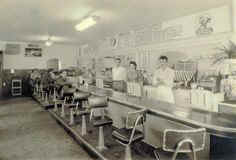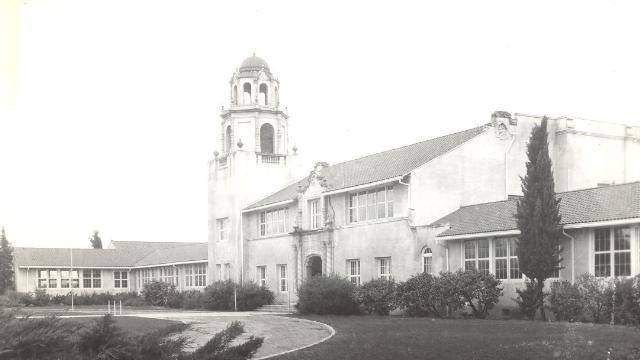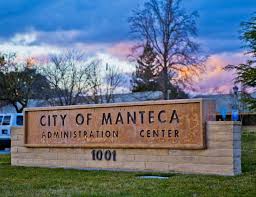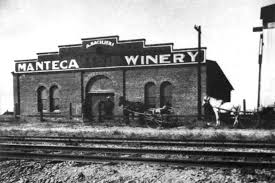| This early misprint of the
city name is a good fact to point out. The fact that the name of
the city is Spanish word, could misdirect our understanding of the
history of Manteca. It was not founded or based on early
Spanish or Mexican colonizers. The families who
settled in rural, in-land Manteca came in well after the Gold Rush and
Treaty of Guadalupe Hidalgo. Manteca is an perfect example of the
aggressiveness and success of Easterners in their participation in
the westward movement.
In 1948 when we moved to Manteca, there were very few
Mexican heritage students. The Spanish teacher was actually
Italian. However; the demographics worked to our
advantage. My sister and I were both hired by the owner of the
local movie house as a usherettes. He was from the Middle East and
wanted to learn to speak Spanish. Interesting,
because most of the non-Anglo community were Portuguese or
Italian. He constantly carried a book around and would ask for
help with pronunciation and sometimes vocabulary. Besides seating
people with a flashlight in hand, the Spanish speaking cashier, who
recruited us, my sister and I were his tutors. I was glad to be
able to help, proud that someone, not of our culture, valued our
language. I was also interested in those who attended the El
Rey Theatre, really the only show in town.
Television was just growing. Most families did not have a
television.
My sister and I did not work the same night, we
alternated. The problem with that, was walking home in the
dark by ourselves. The streets were not well lit on the edge of
town were we lived, some streets did not have
sidewalks.
|

Manteca Main Street, circa 1950s
US Censes Population 3,804
El Rey Theatre on the left.
|
In 1902, J.J. Overshiner built the first store building which was
occupied by a general store and barber shop. The residential area of the
city consisted of only a few homes by 1910, with the population at about
100. Shortly after the opening of the first store, the citizens
petitioned for a post office.
Cost-effective, reliable irrigation was
essential for the development of the area. It was slow in coming but
finally in 1909, an election was held to form the South San Joaquin
Irrigation District and to authorize a bond issue. The bonds were not
issued until 1913. Irrigation water was diverted from the Stanislaus
River about 18 miles northeast of Oakdale. The district built all the
lateral ditches and prepared to deliver water to every 40-acre tract.
That was the town’s real beginning of growth.
The former El Rey Theatre, once an elegant example of the Art Deco style
dating from the 1930’s, including a large triangular-shaped blade marquee
spelling out the theater’s name, was a long-time fixture of downtown Manteca.
During a screening of "The Towering Inferno", ironically, in 1977,
a fire started in the El Rey, and quickly gutted the entire old theater. The
shell of the El Rey would stand ignored for another twenty years. It wasn’t until 1997 that brothers Shon and Joe Kelley saw the El Rey’s
ruins, and decided this was where they would build their new brewery and eatery,
after a $2.5 million reconstruction.
|
 I
was fortunate to be offered a second job, a soda jerk/waitress in
a creamery. There were two creameries in town, one on each end of
Main Street. The two girls who worked there were the head
yell leaders at Manteca High. I really felt
honored to be offered the job, plus sometimes money mom sent
was a little short. I think we had not learned cooking
skills to learn how to stretch the dollar. I
was fortunate to be offered a second job, a soda jerk/waitress in
a creamery. There were two creameries in town, one on each end of
Main Street. The two girls who worked there were the head
yell leaders at Manteca High. I really felt
honored to be offered the job, plus sometimes money mom sent
was a little short. I think we had not learned cooking
skills to learn how to stretch the dollar.
The hours were very comfortable at Smitty's: after all
home games, lunchtime during the school week and Saturdays.
Smitty's was the closes of the two creameries to the high school, so it
was the most popular to the high school crowd, but could be pretty
chaotic after a game. Walking home was not a problem, either
my sister or my boyfriend accompanied me. Ray D. lettered in
football, basketball, and baseball. He was always at Smitty's
after the games and I always felt safe and comfortable with Ray around.
I enjoyed working at Smitty's. Even though
the high school was small, I felt like it kept me in touch with
everyone, all the different groups, all the different
interests, all their varied backgrounds. Saturday was
particularly interesting, the local merchants came in for breakfast or
lunch and chatted about everyone, even high school rumors. I kept
myself busy, but followed every word. It
fascinated me that they were interested in what the high school
students were doing, and seemed to know more than I did.
I realize now that is what a small town is
like. Similar to a church family, when young
couples marry, raise families and even become grandparents, and
you've seen it all. There is a closeness, an interest, curiosity,
and a softness towards those children.
The community closeness can be damning. Several
times Ray warned me not to forma friendships with certain girls
because they had developed bad reputations. Whether
warranted or not, i did not know, but followed his advice.
Fortunately, rumors which were started about my sister and me was
squashed by the mother of one of our friends.
Pat T. mother stood up at a woman's meeting scolding the women for
talking about the Lozano girls, She told them, "Anyone of us
would be grateful to have those girls as our daughters". That
apparently ended it, solidly.
Since the community was made up of Catholics and
Protestants, town people and farm people, I think the thing which held
the community together was Manteca High School. Manteca High
School received amazing support in every facet of high school
life. We knew we mattered, whether it was a game, a fund raiser, a
play, or a fashion show, we mattered. The community was behind
us. The school was only 28 years old when we registered in
1948.

|


 I
was fortunate to be offered a second job, a soda jerk/waitress in
a creamery. There were two creameries in town, one on each end of
Main Street. The two girls who worked there were the head
yell leaders at Manteca High. I really felt
honored to be offered the job, plus sometimes money mom sent
was a little short. I think we had not learned cooking
skills to learn how to stretch the dollar.
I
was fortunate to be offered a second job, a soda jerk/waitress in
a creamery. There were two creameries in town, one on each end of
Main Street. The two girls who worked there were the head
yell leaders at Manteca High. I really felt
honored to be offered the job, plus sometimes money mom sent
was a little short. I think we had not learned cooking
skills to learn how to stretch the dollar.




